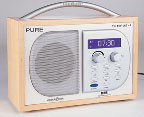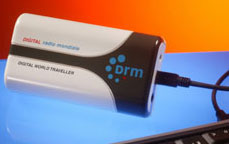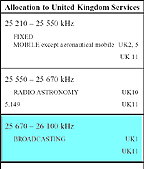Thursday 27 October, 2005, 09:45 - Licensed
Posted by Administrator
Posted by Administrator
 After many years in a sleepy backwater, Digital Audio Broadcasting (DAB) in Europe is finally becoming more mainstream (with one or two exceptions). This is certainly in part due to the fact that the prices for DAB receivers have now dropped to the level where, when buying a new radio for the kitchen, a DAB radio is in the running; and with the extra stations and 'improved quality' they offer, DAB radios are now becoming a must have item.
After many years in a sleepy backwater, Digital Audio Broadcasting (DAB) in Europe is finally becoming more mainstream (with one or two exceptions). This is certainly in part due to the fact that the prices for DAB receivers have now dropped to the level where, when buying a new radio for the kitchen, a DAB radio is in the running; and with the extra stations and 'improved quality' they offer, DAB radios are now becoming a must have item.However, the gradual move towards DAB brings with it a problem for local FM broadcasters whose coverage is limited to a relatively small geographic area. For you see, DAB works by means of a multiplex (mux), whereby a number (typically 8 or more) stations are combined together and transmitted from one or more transmitter sites. The content of the mux must remain identical on all the sites such that all the stations on the mux achieve exactly the same coverage area. This is fine for national stations and for those who cover a relatively large geographic area, or the same city, such that there are likely to be other broadcasters who wish to achieve the same coverage and could share a multiplex; but who would wish to share a multiplex and duplicate the coverage of a neighbourhood or a small rural enclave? The straighforward answer is no-one! So these small scale stations are left with no option other than to continue using FM and hope that DAB does not become the de facto broadcasting standard.
Salvation, however, may come in another form of digital radio, otherwise known as Digital Radio Mondiale (DRM). DRM is designed to offer a replacement for outmoded AM radio on the long, medium and short wave bands, but it has recently had its frequency range extended to 120 MHz so as to offer a possible replacement for FM broadcasters too. For existing AM broadcasters, a move to DRM offers the chance to replicate their existing coverage but with much improved quality ('near-FM quality' is often quoted as being achieveable in an AM channel using DRM).
For AM broadcasters, this is great news: Using the same spectrum they can improve their transmission quality and many broadcasters, especially in mainland Europe, have already done so.
 Using DRM in the FM band is a largely untried quantity and in theory there is no reason why it could not only work but at the same time expand the number of stations that could be broadcast in the FM band, as a DRM transmission takes up only about one tenth the bandwidth of an analogue FM transmission. It may not, though, be an ideal solution for a local FM broadcaster, particularly as at present, the very few receivers that exist for DRM do not cover the FM band (the manufacturers assumed that the standard would only be used on the HF bands below 30 MHz). Also (and I'm sure there are cleverer people than me working on this), the carrier spacing for the OFDM signal of a DRM transmisison varies between 41.66 and 107.5 Hz. At a frequency of 108 MHz, a vehicle travelling at 250 km/h (a train for example, or a BMW on a German motorway) experiences a Doppler shift of 25 Hz. Compared with the 41.66 Hz carrier spacing this is significant, and even at 107.5 Hz carrier spacing it represents a significant difference for the receiver to have to track, and must introduce lots of errors in reception.
Using DRM in the FM band is a largely untried quantity and in theory there is no reason why it could not only work but at the same time expand the number of stations that could be broadcast in the FM band, as a DRM transmission takes up only about one tenth the bandwidth of an analogue FM transmission. It may not, though, be an ideal solution for a local FM broadcaster, particularly as at present, the very few receivers that exist for DRM do not cover the FM band (the manufacturers assumed that the standard would only be used on the HF bands below 30 MHz). Also (and I'm sure there are cleverer people than me working on this), the carrier spacing for the OFDM signal of a DRM transmisison varies between 41.66 and 107.5 Hz. At a frequency of 108 MHz, a vehicle travelling at 250 km/h (a train for example, or a BMW on a German motorway) experiences a Doppler shift of 25 Hz. Compared with the 41.66 Hz carrier spacing this is significant, and even at 107.5 Hz carrier spacing it represents a significant difference for the receiver to have to track, and must introduce lots of errors in reception. There is another cat in a bag which offers a potential solution to the question of a digital replacement for local FM broadcasting in the shape of a little used HF broadcast band. The 11 metre band (25670 - 26100 kHz) is virtually unused by broadcasters as, other than at the peak of the 11 year sunspot cycle, propagation is virtually non-existent except for local ground-wave coverage. During the day at the peak of the cycle, signals travel thousands of miles, especially trans-equatorially (i.e. north to south and vice versa). Experiments have been conducted in Germany which showed that using DRM in the 11 metre band offers good local coverage similar to that which FM enjoys, however there is the potential for occasional long-distance interference during the day. This is, if anything, an improvement on the situation which traditional AM broadcasters enjoy in which there is a virtual guarantee of interference from distant stations every night!
There is another cat in a bag which offers a potential solution to the question of a digital replacement for local FM broadcasting in the shape of a little used HF broadcast band. The 11 metre band (25670 - 26100 kHz) is virtually unused by broadcasters as, other than at the peak of the 11 year sunspot cycle, propagation is virtually non-existent except for local ground-wave coverage. During the day at the peak of the cycle, signals travel thousands of miles, especially trans-equatorially (i.e. north to south and vice versa). Experiments have been conducted in Germany which showed that using DRM in the 11 metre band offers good local coverage similar to that which FM enjoys, however there is the potential for occasional long-distance interference during the day. This is, if anything, an improvement on the situation which traditional AM broadcasters enjoy in which there is a virtual guarantee of interference from distant stations every night!Experiments using the 11 metre band are continuing in Germany and France and in London by WRN (1kW on 26070 kHz from Crystal Palace) and if all goes well, I think we could see a raft of local stations opening up DRM transmissions in this band, complementing their FM coverage and giving them a digital outlet to compete with the growing number of DAB stations. For the sake of small local radio stations, let's hope so.
1 comment
( 1910 views )
| permalink
| 



 ( 2.6 / 35844 )
( 2.6 / 35844 )




 ( 2.6 / 35844 )
( 2.6 / 35844 )

